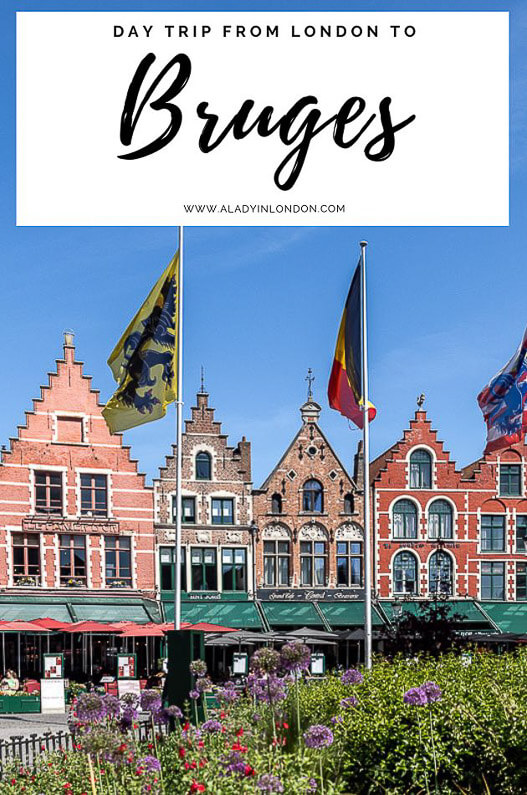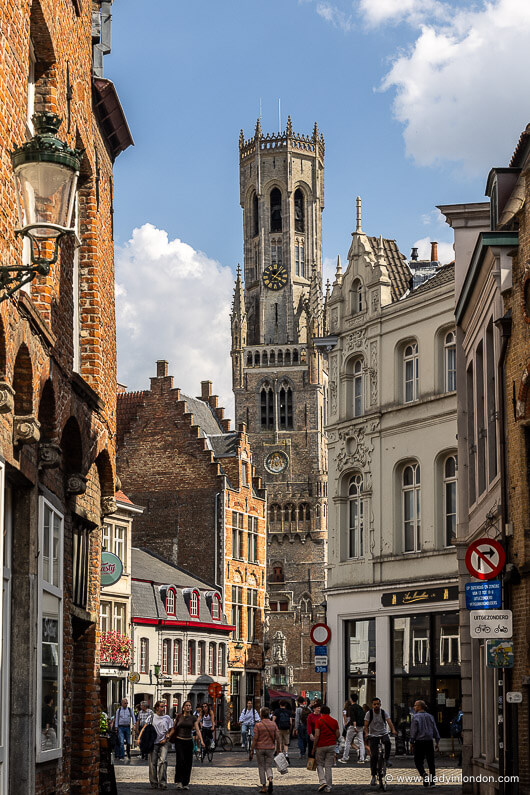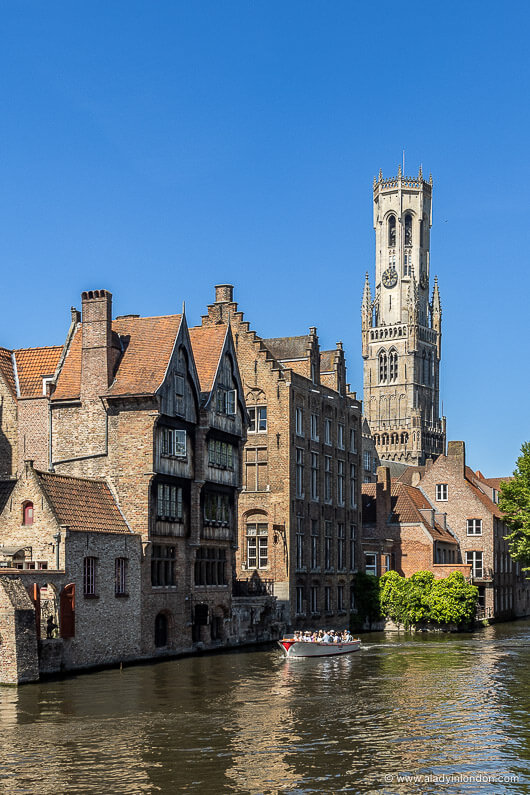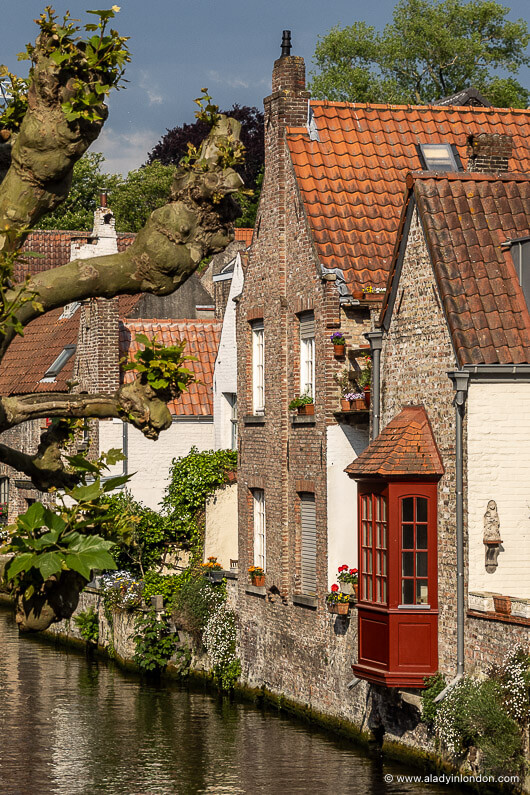Today I want to bring you my guide to how to take a day trip to Bruges from London. This historic city in Belgium is an easy rail journey from the UK capital. While here you’ll find everything from stunning squares to scenic canals and traditional food. I’m in town now and I’m excited to share about my experience with you. I’ve included a map, too.


Day Trip to Bruges from London
In northwest Belgium, Bruges is the capital of West Flanders. Known for its medieval architecture and cobbled streets, it’s one of the most attractive cities in Europe.
Visitors from all over the world flock to Bruges for its charming lanes and grand squares. From De Burg to the Stadhuis and the Grote Markt, this part of the Low Countries has a lot going for it.
Which is why I’m here. I’ve booked myself a day trip to revisit my favorite places in Bruges and discover some new ones. From sightseeing to tours and restaurants, I’m looking forward to my visit.


How to Get to Bruges from London
If you’re wondering how to get to Bruges from London, the best way to travel is by rail. It’s easier than flying, and it can be a lot faster as well. It’s one of my favorite train trips from London to Europe.
You can start by taking a train from London to Brussels Midi/Zuid. From there it’s an easy change to a train to Bruges. It takes around 2 hours to get to Brussels and another hour to get to Bruges.
With a 15-minute layover in the Belgian capital, the total journey takes just over 3 hours (but remember there’s a 1-hour time difference between the UK and Belgium). If you prefer a guided tour, you can book one from Brussels here.


Bruges
After departing London on a 6:15am train, I arrive in Bruges at 10:30am and walk the short distance from the station to the heart of the old town.
I’m hungry from the journey, so I sit down at a sunny table in a square and order breakfast from the well-known Belgian restaurant Le Pain Quotidien.
A classic croissant and hot coffee go down a treat as I watch the world go by around me. It’s a great way to start my trip.


Grote Markt
Appetite taken care of, I continue my day trip to Bruges with some sightseeing. I start in the Grote Markt (Grand Place if you speak French), or Market Square.
It’s dominated by the towering Belfry. At 272 feet (83 meters) high, this UNESCO World Heritage Site is the most prominent building in the city.
Around the Belfry are medieval buildings of all shapes and colors. I admire them as horse-drawn carriages clip-clop through the square and roll past tour groups from all over the world.


De Burg
From the Grote Markt I walk down Breidelstraat to get to De Burg. Like the Grote Markt, it’s a famous square. De Burg is home to the Basilica of the Holy Blood, which is renowned for housing a vial that allegedly contains a cloth with the blood of Jesus.
De Burg is also where you’ll find the Stadhuis, or City Hall. This eye-catching building dates back to 1376. It features a striking Gothic interior that houses a museum dedicated to art and history.
Also in De Burg is Brugse Vrije, an 18th-century courthouse with an ornate Baroque facade. Around the square are restaurants with tables spilling out onto the cobbles.


Sightseeing
After walking around De Burg and popping into the Basilica of the Holy Blood and Stadhuis, I make my way down Blinde-Ezelstraat and across the Blinde-Ezelbrug bridge. Here I get my first glimpse of the city’s famous canals.
After admiring the view, I walk over to the Vismarkt to take in the historic colonnades. It’s the oldest preserved fish market in Belgium, and you can still buy fresh seafood here between Wednesday and Saturday.
From the market I meander through the Huidenvettersplein, a small area with historic facades and several restaurants.


Soon I emerge to be treated to the famous view from Rozenhoedkaai. With a bend in the canal, it shows off the medieval architecture and stunning waterways the city is known for. It’s a great photo spot.
After taking some pictures, I walk along the waterfront. I pass the scenic Nepomucenus Bridge, enjoy the shade of the trees in De Dijver park, and head into a courtyard called Arentshof.
Here I find The Four Horsemen of the Apocalypse, a group of bronze sculptures by Belgian artist Rik Poot. Near them is the famous Boniface Bridge. It’s an early-20th-century pedestrian number with picture-pretty views of the canals and the Church of Our Lady.


I spend some time taking photos and videos, admiring the canal boats, and taking in the scene. It’s busy with tour groups, but it’s so beautiful I understand why.
I cross over the bridge, then walk around the back of the church to get to Mariastraat. I walk south down the street, taking in the shops and restaurants as horse-drawn carriages go by.
When I reach Wijngaardstraat, I walk west and pass more boutiques and cafes on my way to Wijngaardplein. This picturesque place has stunning views of the canals.


Across Begijnhof Bridge, I find myself entering the Beguinage. This unique complex consists of a large courtyard surrounded by 17th-century buildings.
Nuns and religious laywomen occupy the Beguinage, which dates back to 1245. It’s peaceful and quiet, and a nice change from the bustling streets outside.
After exploring the Beguinage, I walk along Begijnhof. There are great views across the water here, and I admire them before heading back to Wijngaardplein.


Lunch
For lunch I go to Tonka Tearoom on Walplein. This place has modern decor and friendly staff. I sit outside in the small courtyard and order a filling meal of smoked salmon and asparagus toast. It’s just what I need to fuel up for my afternoon in Bruges.
Shopping
Leaving the restaurant, I head farther up Walplein. I duck into the De Halve Maan Brewery, which dates back to 1856 and offers tours. From there I wind down narrow streets like Stoofstraat as I make my way to the next stop on my itinerary: a chocolate shop.
No trip to Belgium would be complete without chocolate, and Chocolaterie Mary is one of the prettiest chocolate shops in Bruges. Dating back to 1919, Maison Mary has been a certified purveyor to the Belgian Court since 1942.
Today it blends tradition with modernity, from its feminine decor and packaging to its mouth-watering pralines. I pick up some chocolates as a gift for my other half, secreting them away in my bag to keep myself from eating them.


Canal Boat Tour
Back outside, I continue my day in Bruges with a canal boat tour. No trip to the city would be complete without one, and I’m excited to get out on the water.
The 30-minute tour takes me and my fellow passengers through the canals of Bruges. It’s a great way to see the sights, not to mention a good opportunity to rest my legs after a lot of walking.
The tour takes us past some of the most famous landmarks in Bruges. From Saint John’s Hospital to the Groeninge Museum, historic mansions, almshouses, and the Burghers’ Lodge, we see a range of buildings as we cruise along the canals. If that appeals, you can book a boat tour here.


Sightseeing
Back on land, I continue my day trip with a visit to the Church of Our Lady. This stunning Gothic number was founded in the 13th century. Its exterior is best known for its eye-catching tower, and its interior is famous for being home to Michelangelo’s Madonna of Bruges sculpture.
After visiting the church, I pop next door to admire the stunning courtyard of the Gruuthusemuseum, a place that displays historic furniture, sculptures, and tapestries.
From there I walk along the canals to the end of Groenerei, then meander through the streets until I find my way back to the Grote Markt.


Cafe
I’m in need of a rest, so I pop into a cafe called EspressoBar – I Love Coffee on Sint-Jakobsstraat. There’s a little courtyard out back that’s perfect for relaxing, and I take full advantage of it.
Sightseeing
Energy restored, I walk up to the end of Sint-Jakobsstraat. There are beautiful residential streets around it, and I take a while to get lost in them.
After doing so, I walk all the way down to St. Salvator’s Cathedral. Dating back to the 12th century, it’s the oldest parish church in Bruges. The cathedral is known for its medieval tombs, Brussels tapestries, and centuries-old Flemish paintings.


Snack
With a little time left before my train back to Brussels, I make my way down Heilige-Geeststraat and Mariastraat to FritBar. As the name implies, I’m here to have fries. They’re one of my favorite things to eat in Belgium, and no trip would be complete without this guilty pleasure.
Train
Fries consumed, I walk back to the train station and start my journey home to London. I leave the station at 6:30pm, grab a sandwich for dinner at Panos in Midi/Zuid station in Brussels, and arrive back at St Pancras just before 10pm.
In all, I spent 8 hours in Bruges. I felt like it was enough time to see and do a bit of everything in the city. With the train journey on either end, it was a long day, but it was worth it. If you’d rather save some energy and stay a night, you can book a hotel here. Bruges is a great weekend trip to Europe.


But given how easy it is to take a day trip to Bruges from London, I know I’ll be back again before long. I hope my blog post has inspired you to visit, too. If you want more ideas, you can take a look at my blog post about the best day trips from London to Europe.
Bruges Map
Find this post helpful? Buy me a coffee!
New here? Join thousands of others and subscribe to the A Lady in London blog via email.
Some of the links in this blog post are affiliate links. At no cost to you, I earn a small commission when you click on them and make a purchase. It doesn’t affect the way you shop, and it’s a great way to support the A Lady in London blog.
Pin it!




